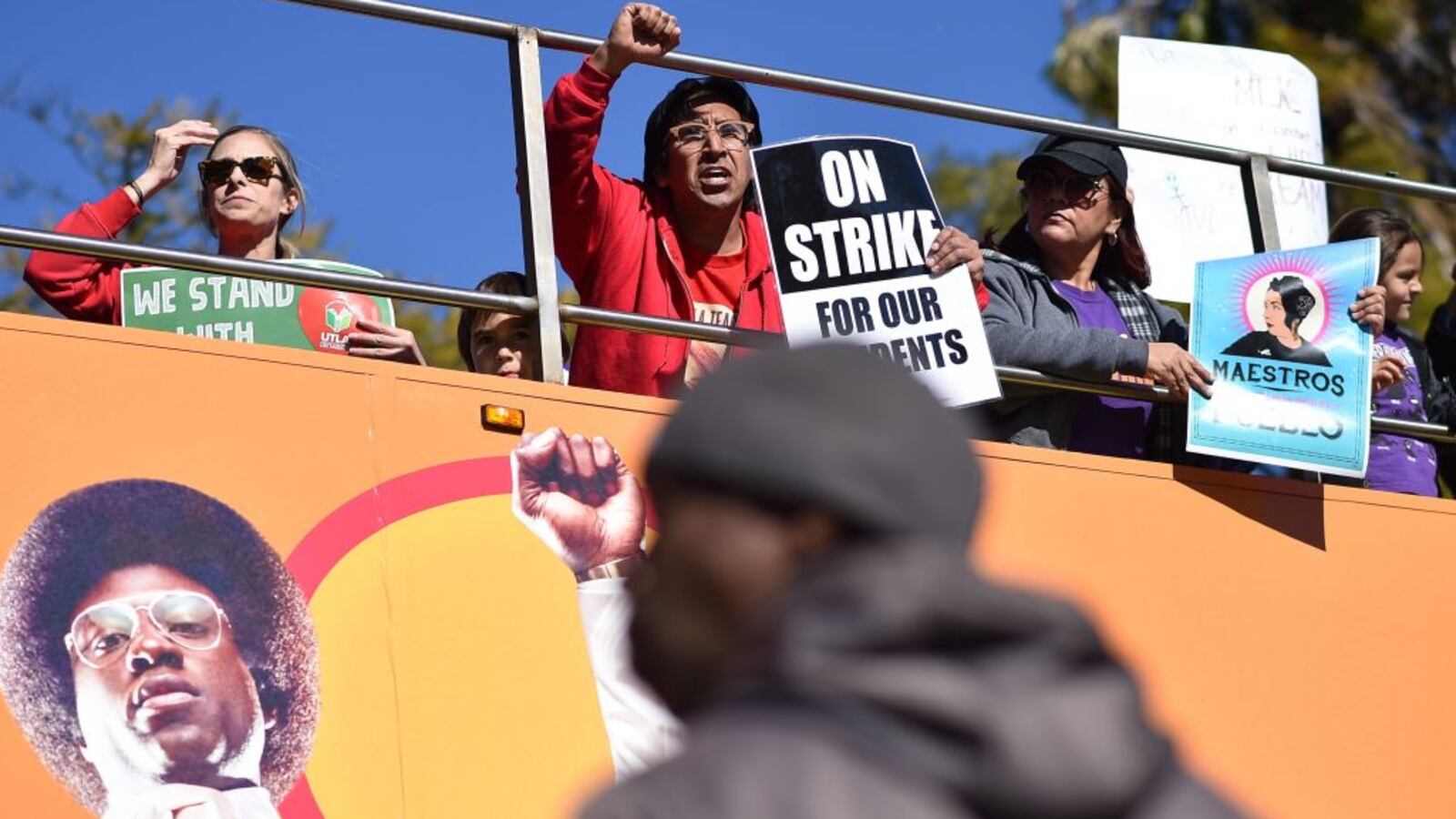Striking Los Angeles-area educators are expected to be back in their classrooms Wednesday, after the union that represents them struck a deal with the district.
The agreement, which boosts teacher pay by 6 percent, comes on the heels of a contentious and protracted contract dispute, during which salaries, class sizes, funding for nurses and counselors, and charter school growth were all at issue. The deal announced Tuesday morning will end the walkout that has lasted six school days and captured national attention.
“This is much more than a narrow labor agreement — it’s a broad compact” that furthers social justice and racial justice, said the president of United Teachers Los Angeles, Alex Caputo-Pearl, speaking alongside district superintendent Austin Beutner and Los Angeles Mayor Eric Garcetti at a Tuesday morning press conference.
United Teachers encouraged its members to approve the deal, and Caputo-Pearl signaled Tuesday evening that they had. Preliminary figures, he said, showed “a vast supermajority are voting yes.”
The union won a significant victory in eliminating a clause that has allowed the district to ignore class-size caps in times of financial distress. And to bring class size in line with the mandated caps, district schools will reduce class sizes by four or more students by 2022.
Still, the rules will allow classes far larger than national averages for city schools. The class caps with which the district seeks to comply are roughly 29 students for kindergarten, 32 students in grades 1-3, and 39 students in upper elementary school grades. (Magnet schools and neighborhood schools designated as serving mostly Hispanic, black, or Asian students have lower caps.) Middle and high schools cap classes at 42 students, though the district has agreed to limit English and math classes to 39 students next year.
L.A. Unified will hire 300 additional full-time nurses, and provide nursing services five days a week at every district school. The district also agreed to hire more teacher librarians and counselors, ensuring a librarian five days a week at every secondary campus and student-to-counselor ratios of roughly 500 to 1.
The district also agreed to designate 30 community schools, which typically provide students and their families wrap-around health and social services.
At the Tuesday morning press conference, the union chief and the district leader struck a collegial tone — shaking hands and putting aside the angry rhetoric targeting the superintendent that dominated much of the strike. On the picket lines during the past week, many chants and signs portrayed Beutner, a former investment banker, civil servant, and newspaper publisher, as a force for “privatizing” public education through the expansion of independent charters.
The union had been calling for a moratorium on new charter schools. The district agreed to bring to a school board vote a resolution that calls on the state to establish a charter cap and to create a state committee on charters. Under the terms of the contract, district schools that share a campus with a charter school will also have more input in how the co-located space is used.
Mayor Garcetti, who has no formal oversight role of the L.A. Unified district but whose team helped facilitate negotiations, called for an end to negative caricatures on both sides. “They need each other, and we need them to need each other,” he said of Beutner and Caputo-Pearl.
Beutner, who during the course of the strike insisted the union’s demands would drive the district to the brink of insolvency, said the deal has L.A. Unified investing “every nickel we have” to improve local schools.
Still, he said, “We can’t solve 40 years of underinvestment in public education in just one week.”
To take effect, the Los Angeles Unified school board must also ratify the tentative agreement.
Alicia Dobrow, a third-grade teacher at Carpenter Community Charter, a district-affiliated school in Studio City, said the strike has been “very stressful for parents, stressful for students and stressful for teachers.” So upon learning a deal had been reached, she said, “my initial thoughts were elation and gratitude, but now reading over the entire 40 pages, I’m somewhat disappointed.”
She is thrilled that the district struck the provision allowing it to disregard class-size caps, but said the contract doesn’t solve the widespread issue that teachers still have too many students to teach. She also said it doesn’t go far enough when it comes to reducing the amount of standardized testing.
Anthony Robinson, a special education teacher at Sixth Avenue Elementary School, meanwhile, was a yes vote. “There has to compromise,” he said. “We didn’t get everything we desired but there was substantial progress on the issues most important to me — like having a nurse on site every day.”
On his first day back in the classroom, he plans to talk to his students about the strike and its resolution. “I’ll ask, ‘Do you know why we were out there?’” he said. “I’m curious to see their perspective. The last time I did something like this was the presidential election 2016.”
The walkout marked the first strike since 1989 in the nation’s second-largest school district and affected more than 500,000 students in and around Los Angeles.


